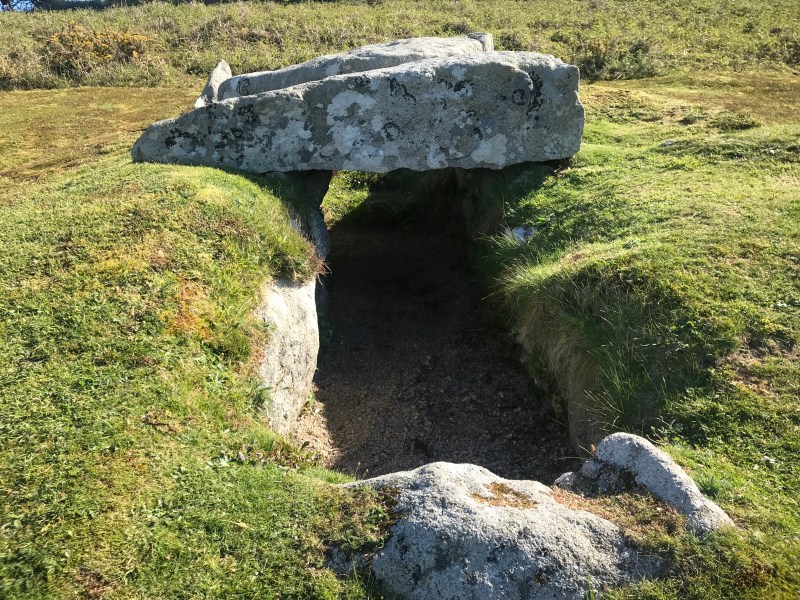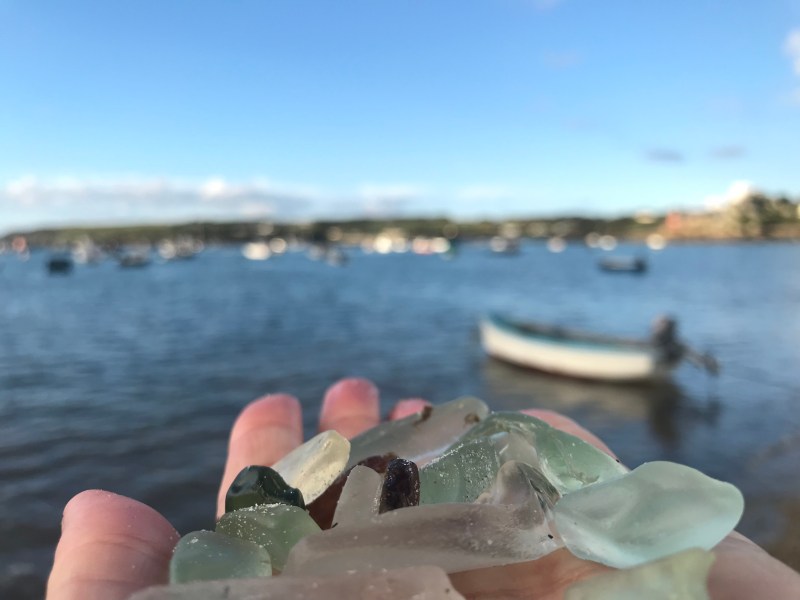The British Isles of Scilly, a dreamy, palm-fringed archipelago off the Cornish coast, are so very, very off the beaten path that even most English folk have never heard of them. That’s a bit unfortunate for them, but a great advantage for travelers who want to avoid the crowds and enjoy the feeling of being whisked back in time to a much more charming and simple era.
The islands have a properly British, tongue-in-cheek humor about their name, which is pronounced “silly,” and are full of wonderfully novel characters…all two thousand of them.
Fishing nets dot the shore at one of the coves in the Scilly Islands. (Photo credit: Kinga Philipps)In the land of magical train platforms and enchanted wardrobes, arriving on Scilly can feel like you’ve likewise been transported to a dream land where the famously dour and damp English climate no longer exists. Alas, science has a way of explaining things logically—to the disappointment of many of us. It is the islands’ proximity to the warm air of the jet stream that makes them feel more like the Mediterranean than mainland Britain.
As a result, you’ll unexpectedly encounter the occasional palm tree on the Scilly isles, giving them the deceptive air of someplace equatorial…a subtropical paradise in scientific lingo. The Caribbean-esque seas and golden beaches add to the illusion until you become mesmerized by the fantasy of it all and decide to go for a plunge. Those azure blue waters will be sure to shock you back to reality, however. While scuba diving, I rarely saw a surface temperature of more than 50 degrees Fahrenheit, but in true British fashion there was always hot tea waiting for me aboard the dive boat when I emerged, shaking like a leaf and lacking all motor skills in my hands.
This would be a proper place to mention one of the most phenomenal luxuries in British diving: dive elevators. A simple platform that, with the touch of a button, lowers and raises a diver in all their gear to and from the boat deck with minimal effort. This might seem an unnecessary extravagance for someone from the U.S. who is only familiar with disassembling her gear in the water while being battered by swell after swell and then hoisting herself both unceremoniously and ungracefully into the craft. This amenity felt downright decadent and apparently the Brits won’t book a dive boat without it.

Charm, peace, tranquility, uncrowded and unspoiled are all words one could pluck from the thesaurus to describe this slice of pastoral Shangri-La. Aside from serenity, the area offers history, including a seemingly unending concentration of shipwrecks with tales that put Jack and Rose to shame and a plethora of outdoor activities to satisfy nearly every traveler.
A two hour ferry ride aboard the Scillonian III from Penzance, a beautiful spot in its own right, deposits you at St Mary’s harbor in Hugh Town. En route you might spot whales and basking sharks if luck is on your side. Even the odd submarine has shown up for a quick hello…a visit that seems as unnerving as it is cool.
By air, there are flights from Southampton, Bristol, Exeter, Newquay and Land’s End. The St Mary’s airport is nostalgically low key where everyone is allowed into the terminal next to a pasture full of grazing horses. The runway is not closed off either and, in fact, ends just over the rugged coast where the hiking trail crosses over…only requiring you to move quickly and not stop when the red lights flash indicating a plane is in the midst of taking off. The quick flight to and from the mainland offers sweeping views of the English countryside and countless small coastal communities that beg to be the backdrop for some hard-to-put-down novel about perseverance and once-in-a-lifetime romance.
Diving, snorkeling, biking, kayaking, stand up paddle boarding, horseback riding, hiking, coasteering—a rather British sport that blends rock pooling, swimming, climbing and diving—are all available to get the blood pumping. Thanks to the aforementioned shipwrecks, there is enough wreck diving to satiate even the most determined history buff. And countless outfitters offering deep sea fishing to round off the activities list. For those less hell bent on adventure there are more nooks and crannies suitable for reading a novel or sipping a pint than can be found on a Thomas’ English Muffin. St Mary’s even boasts a vineyard that has been producing its own wine since 2014 where you can swing by for a tour and tasting and maybe toss a bottle in your picnic basket to enjoy later at the outdoor cinema.
Art abounds. From quirky to fine. Ceramics and sand installations compete for your interest with more unusual events such as walks offering “sound ecology”…where you listen in on the underwater world around you through hydrophones.
As for cuteness factor , the isles don’t disappoint either. Puffins and grey Atlantic seals are the main attraction, with snorkeling tours putting you face to whiskers with the adorable pinnipeds who can be seen lounging on the jagged rocks like insulated mermaids.
Time seems to move more slowly and brings with it a sensation of direct connection to intriguing local history from way, way back…like 4,000 years ago… to more recent maritime moments that changed navigational practices to the more modern and beautiful story of the islands’ flower farming heritage. Scilly has been inhabited since the Stone Age and both the Vikings and the Romans have trod her golden shores. As such, several burial chambers of ancient civilizations remain well preserved and open to public wanderings. In all, the tiny land mass is home to an astonishing 239 monuments—there is a greater density of historical sites here than anywhere else in the British Isles.

Over years of travel, I’ve mastered the art of wandering aimlessly and found it to be an invaluable tool for getting to know the intimate corners of a place. A few hours into an in-depth exploration of the island seashore and I bestowed upon Scilly the distinction of being the only place on the planet I’ve ever gotten sick of sea glass hunting. The ubiquitous presence of the colorful bits of litter turned sea gems, and the ease of gathering them, soon weighs down your pockets and, ultimately, makes it less alluring. Part of their abundance is due to the tides, which are truly uncanny. At low tide most vessels in the harbor sit beached, resting on their keels, until the water rushes back a few hours later to lift their bows skyward.

The isles consist of five inhabited and more than 150 uninhabited islands. Some are little more than serrated rocks materializing from the sea in between waves. A rather tragic realization for ships back in the day. St. Mary’s, Tresco, St. Martin’s, Bryher and St Agnes are the ones with regular human footprints. The archipelago was designated as an Area of Outstanding Natural Beauty in 1975. Certainly a wise choice.

My most cherished memory of St Mary’s is the coastal walk. A 10-mile hike that circumnavigates the island leading you through flower fields, past ancient burial chambers, along stretches of pristine beach, around inlets where colorful fishing boats rest and on the edges of cliffs with sweeping views of the ocean. A backpack with snacks, water, a light jacket for sudden and frequent weather changes and a camera are a must. The normally five-hour stroll was so captivating and peaceful I spent an extra few hours daydreaming on the wooden benches that mark the trail and occasionally stopping for a nap in meadows filled with apple trees, carpets of flowers and buzzing bumblebees. October is birdwatching season and spring is an explosion of color from kaleidoscopic blooms that have their own story.
The area’s role in the floral trade began in the late 1800s, when a box of local wild narcissi was sent to the famed Covent Garden market in London, creating so much buzz that flower farming became the leading enterprise on the islands almost overnight. More than 100 years later, it continues as the second largest industry and the famed flower farms produce daffodils, narcissi and jonquils, decorating the islands’ fields in blankets of gold.
Meadows abound along a 10-mile coastal walk. (Photo credit: Kinga Philipps)As for accommodations on Scilly, they range from the luxurious Star Castle—a former military fortress constructed to protect the islands from Spanish invasion—to a various assortment of B&Bs, vacation rentals and even glamping or camping. Half board is another option…it’s like a bed and breakfast, but with dinner included instead of the morning meal.
You can even enjoy the islands from aboard a classic vessel, including historic tall ships and more modern research yachts.
Think British food is boring? Throw that idea out the window as soon as your footfalls grace the cobblestones of St. Mary’s pier. World class cuisine, proper fish and chips and an assortment of succulent strawberries, lobster, Bryher bangers, tattie cakes, infused gins, and spiced salt round off what could easily be a foodie tour of the islands. And that 10-mile walk serves as a good way to build up your appetite—or walk off the calories.
One of the most peaceful spots on St Mary’s is the tiny Old Town Church and surrounding cemetery. It’s beautiful, verdant grounds remind us yet again of the region’s reputation as a ship graveyard. Several monuments mark bygone maritime tragedies and dozens of small, simple graves indicate the final resting place of unnamed sailors who never made it home.

There are 530 registered wrecks around the archipelago, more than anywhere else on Earth, earning the Scilly Islands the dubious honor of being the Shipwreck Capital of the World. Back before the days of radar and GPS, the area was particularly hazardous, as any small miscalculation could cost you dearly.
The tides, currents and cold turbid waters make scuba diving difficult, but it you will be rewarded if you plunge ahead. The islands’ shipwrecks span centuries and many of them have yet to be discovered. They tell stories of everything from the slave trade to one of the U.K.’s worst naval disasters.
In 1707, a navigational error sent four British warships of the Royal Navy fleet aground on Scilly’s unforgiving rocky pinnacles. Two of the more famous vessels were the Firebrand and the Association. Having mistaken Scilly for the mouth of the English Channel, the incident was one of the greatest maritime disasters in British history. Over 1,600 sailors lost their lives and the tragedy resulted in a competition for a more precise method to determine longitude. To put this tragedy in perspective, the Titanic’s loss of life more than 200 years later was around 1,500.

Another famous shipwreck with an interesting story is the German ferry, the Schiller, that went down in 1875. She was one of the largest ocean-going ships in her day and 335 men, women and children lost their lives when she sailed into thick fog and was swamped by a series of massive waves. There were only 27 survivors. The Germans were so impressed with the way the people of Scilly handled the tragedy that orders were given during the two world wars that Scilly should be spared.
The local museum is a well organized and worthy destination to see examples of everything from local flora and fauna to countless items recovered from shipwrecks. I spent many poignant moments fixated on a dinner plate that once offered someone a final hot meal and pondering a rosary owned by the captain of a slave trading vessel, creating ethical chaos in my heart that someone could be so pious just a few feet above the wooden planks where fellow human beings were chained in squalor.
Other insightful, yet tragic, tidbits stuck with me long after my flight home. During Victorian days, women were helpless victims of sinking ships not only because of cold, rough sea conditions, but because it was a common practice to sew valuables such as jewelry into the many folds of their dresses for safe keeping during travel. It might have kept the possessions secure, but if one had to abandon ship, the weight of such items and water logged layers of costume dragged them into the depths almost immediately.
When you eventually depart the Scilly islands and reenter the modern world the effect can be a bit intimidating and overwhelming. But the sensation of having slipped through an enchanted portal stays with you. It lingers in dreamlike recollections of apple trees, bumblebees and walks along majestic emerald green cliffs. Your fingers slip into your pocket, brushing the polished sea glass and reminding you that somewhere behind you the tides are doing what they’ve done for millennia, visiting Scilly’s golden shores.
For more travel news, tips and inspo, sign up for InsideHook's weekly travel newsletter, The Journey.






















